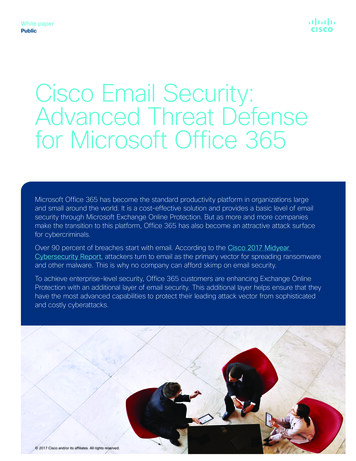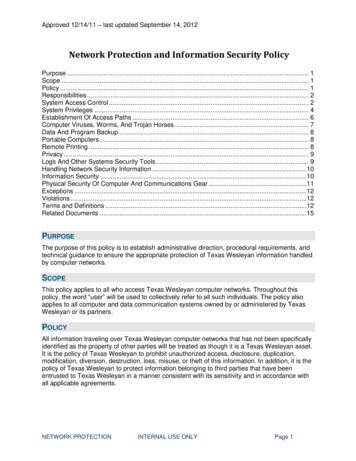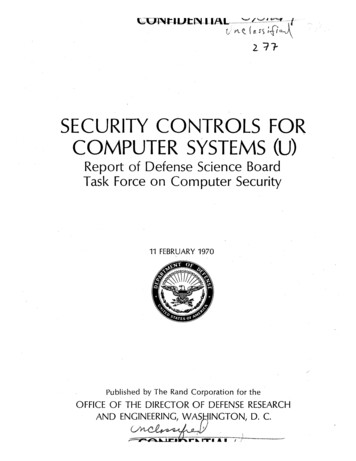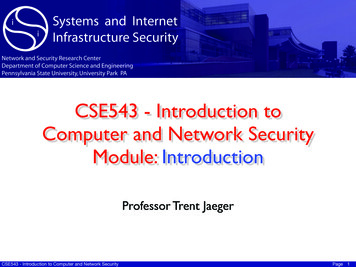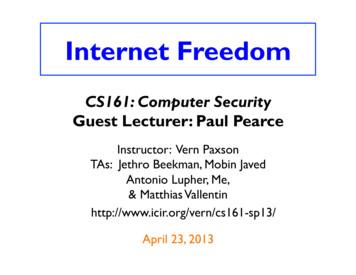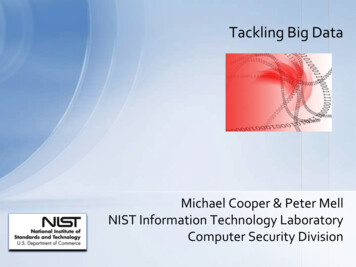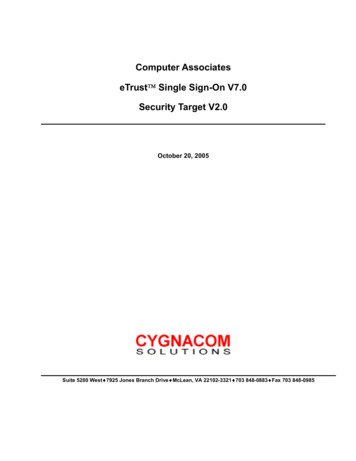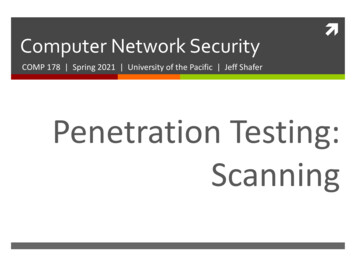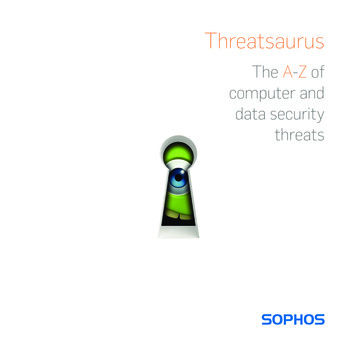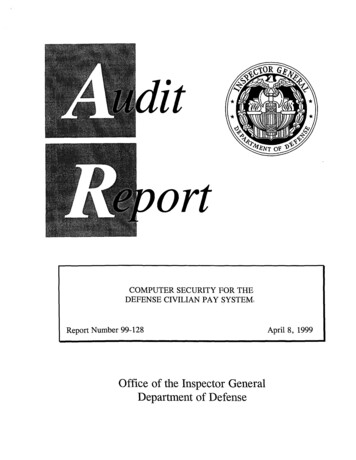
Transcription
itortCOMPUTER SECURITY FOR THEDEFENSE CIVILIAN PAY SYSTEM.Report Number 99-128Office of the Inspector GeneralDepartment of DefenseApril 8, 1999
Additional CopiesTo obtain additional copies of this audit report, contact the Secondary ReportsDistribution Unit of the Audit Followup and Technical Support Directorate at(703) 604-8937 (DSN 664-8937) or FAX (703) 604-8932 or visit the InspectorGeneral, DoD, Home Page at: www.dodig.osd.mil.Suggestions for AuditsTo suggest ideas for or to request future audits, contact the Audit Followup andTechnical Support Directorate at (703) 604-8940 (DSN 664-8940) orFAX (703) 604-8932. Ideas and requests can also be mailed to:OAIG-AUD (ATTN: AFTS Audit Suggestions)Inspector General, Department of Defense400 Army Navy Drive (Room 801)Arlington, VA 22202-2884Defense HotlineTo report fraud, waste, or abuse, contact the Defense Hotline by calling(800) 424-9098; by sending an electronic message to Hotline@dodig.osd.mil; orby writing to the Defense Hotline, The Pentagon, Washington, DC 20301-1900.The identity of each writer and caller is fully MCSEOGSOIDISSOMVSssoTIGAutomated Data Processing Special Security OfficerAutomated Information SystemComputer Associates International, Inc.,Access Control Facility 2Defense Information Systems Agency Area CommandDefense Civilian Pay SystemDefense Finance and Accounting ServiceDefense Information Systems AgencyDefense MegacenterSystems Engineering OrganizationGlobal System OptionIdentificationInformation System Security OfficerMultiple Virtual StorageSystem Support OfficeTechnical Implementation Guide
INSPECTOR GENERALDEPARTMENT OF DEFENSE400 ARMY NAVY DRIVEARLINGTON, VIRGINIA 22202April 8, 1999MEMORANDUM FOR DIRECTOR, DEFENSE FINANCE AND ACCOUNTINGSERVICEDIRECTOR, DEFENSE INFORMATION SYSTEMSAGENCYSUBJECT: Audit Report on Computer Security for the Defense Civilian Pay System(Report No. 99-128)We are providing this final report for review and comments. We consideredmanagement comments on a draft of this report when preparing the final report. This isour second audit report on security software and application controls over the DefenseCivilian Pay System.DoD Directive 7650.3 requires that all recommendations be resolved promptly.The Defense Finance and Accounting Service comments conformed to the requirementsof DoD Directive 7650.3; therefore, additional comments are not required from thatorganization. The Defense Information Systems Agency comments were partiallyresponsive. We request that the Defense Information Systems Agency provideadditional comments on Recommendations C.2.a. and C.2.b. by June 7, 1999.We appreciate the courtesies extended to the audit staff. Questions on the auditshould be directed to Mr. Brian M. Flynn at (703) 604-9145 (DSN 664-9145)(BFlynn@dodig.osd.mil) or Mr. W. Andy Cooley at (303) 676-7393 (DSN 926-7393)(WCooley@dodig.osd.mil). See Appendix C for the report distribution. The auditteam members are listed inside the back cover.Mi)&. Robert J. LiebermanAssistant Inspector Generalfor Auditing
Office of the Inspector General, DoDApril 8, 1999Report No. 99-128(Project No. 7FD-2023.01)Computer Security forthe Defense Civilian Pay SystemExecutive SummaryIntroduction. This is the second audit of security software controls for the DefenseCivilian Pay System, a civilian pay application. In FY 1991, the Defense Civilian PaySystem was approved as the migratory civilian pay system for DoD. The applicationserves 733,000 employees and processes more than 38 billion in payroll transactionsannually. Employee pay records and account data are maintained by the DefenseFinance and Accounting Service (DFAS) Denver Center, Denver, Colorado, and DFASOperating Locations in Charleston, South Carolina, and Pensacola, Florida. Computerprogramming support is provided by the DFAS Systems Engineering Organization,Pensacola. The Defense Information Systems Agency Area Command, Mechanicsburg,Pennsylvania, and Systems Support Office, Dayton, Ohio, provide computer supportfor the pay data maintained by DFAS.Objectives. The primary audit objective was to determine whether security softwarecontrols over the Defense Civilian Pay System adequately safeguarded the data integrityof employee payroll records. The audit also evaluated the management controlprogram of DFAS and the Defense Information Systems Agency related to the otheraudit objectives.Results. DFAS and the Defense Information Systems Agency needed to improvecomputer security over the Defense Civilian Pay System and its mainframe computers. Global System Option settings, which contain the standard system-wide securitycontrol options, were not established on the mainframe computers used forcivilian pay processing in accordance with standard guidance. In addition, useraccess to sensitive privileges and mandatory password requirements was notadequately controlled. As a result, the Defense Information Systems Agencycould not ensure the integrity of the mainframe computers that support thecivilian pay application (Finding A). Inactive user identifications were not deleted from the production processingplatforms for civilian pay when user access was no longer required. In addition,password controls were not adequately administered to ensure the authenticationof all users who had access to civilian pay data. Likewise, password resetcapability was not uniformly administered by or adequately restricted to securitypersonnel. Consequently, the integrity of the civilian pay data was at risk(Finding B). Inadequate controls existed over Government and contract personnel who hadsensitive access to application software and civilian pay data. When thisproblem was brought to management's attention, corrective actions were taken;however, additional improvements are needed (Finding C).
No instances of fraud or abuse were detected. Because of their sensitive nature, thedeficiencies discussed in this report are presented in general terms. Details of thefindings and other matters were provided separately to management. For details of theaudit results, see the Findings section of the report. See Appendix A for details of themanagement control program.Summary of Recommendations. We recommend that the Defense InformationSystems Agency perform a security review on the mainframe computers that supportthe civilian pay application and implement standard system controls in accordance withagency guidance. We further recommend that all positions requiring sensitive access bedesignated critical-sensitive, and that background investigations be completed on allpersonnel in these positions. We also recommend that DFAS require users who haveaccess to the pay application to change their password every 90 days. Further, werecommend that DFAS review all inactive users and delete users who no longer needaccess. We recommend that DFAS modify user authentication programs, establishprocedures for issuing and resetting user passwords, and restrict password resetcapability to defined security personnel.Management Comments. The Defense Information Systems Agency concurred withall recommendations. A security review will be performed on the mainframe computerthat supports the civilian pay application. This comprehensive review will ensure thatall standard settings and security safeguards conform to established guidance. Inaddition, 90-day minimum password change requirements will be enforced for all users.The Defense Information Systems Agency also stated that sensitive positions assignedto Government and contract personnel at the Defense Information Systems Agency AreaCommand, Mechanicsburg, will be designated critical-sensitive and backgroundinvestigations will be obtained for individuals assigned to those positions.DFAS concurred in principle with three recommendations. The 90-day passwordchange requirement will be established for the majority of civilian pay users. However,nonexpiring passwords will be permitted for agencies that interact with the applicationonly through batch interfaces. Management agreed to delete inactive users after aspecified amount of time. Because the second layer of security is unique to civilian payand is not required, DFAS will remove this layer and rely on the primary security layercontrolled by the security software for user authentication and verification. DFAS fullyconcurred with two recommendations. Management will publish procedures for issuingand resetting passwords for all civilian pay users. Password reset capability will berestricted to the personnel required to perform this function.Audit Response. The Defense Information Systems Agency comments were partiallyresponsive. Management agreed to designate sensitive positions as critical-sensitiveand to obtain background investigations for all personnel assigned to these positions atone location. However, the Defense Information Systems Agency did not respond tosimilar recommendations concerning personnel assigned to sensitive positions at itsSystems Support Office, Dayton. We request that the Defense Information SystemsAgency provide comments on those recommendations by June 7, 1999. The DFAScomments were fully responsive, and additional comments are not required. Adiscussion of management comments is in the Findings section of the report, and thecomplete text is in the Management Comments section.ii
Table of ContentsExecutive A. Adequacy of System ControlsB. DCPS Security ControlsC. Critical-Sensitive Ratings3813AppendixesA. Audit ProcessScopeMethodologyManagement Control ProgramB. Summary of Prior CoverageC. Report Distribution1718182021Management CommentsDefense Finance and Accounting Service CommentsDefense Information Systems Agency Comments2327
BackgroundSystem Overview. The Defense Civilian Pay System (DCPS) was approved bythe Under Secretary of Defense (Comptroller) as the DoD migratory civilianpay system in September 1991. The primary objective of DCPS is tostandardize DoD civilian pay and to fulfill all pay-related reportingrequirements. To accomplish this, DCPS maintains employee records thatcontain pay and leave entitlements, deductions, withholdings, time andattendance data, and all other information pertinent to an employee'semployment status. DCPS users consist of the Military Departments, theDefense Finance and Accounting Service (DFAS), and other organizations in theFederal Government. DCPS currently services 733,000 payroll accounts andprocesses payroll transactions valued at more than 38 billion annually. DCPSwas fully implemented in June 1998.Supporting Organizations. Four DFAS organizations and the DefenseInformation Systems Agency (DISA) provide support for the DCPS applicationand mainframe computers.DFAS Systems Engineering Organization. Software development,design, testing, and other central design support for the DCPS ap lication isprovided by the DFAS Systems Engineering Organization (SEO), Pensacola,Florida.DFAS Payroll Offices. The payroll office at the DFAS Denver Center,Denver, Colorado, and DFAS Operating Locations in Charleston, SouthCarolina, and Pensacola maintain employee pay records and DCPS accountdata.DISA. The DCPS application resides on separate mainframe computersat the DISA Defense Megacenters (DMC) in Mechanicsburg, Pennsylvania, andin Denver. 2 The DCPS processing environment (the WCC3) at DMCMechanicsburg supports the employee account data maintainedby the DFAS Operating Locations in Charleston andPensacola. DMC Mechanicsburg provides executive softwaresupport for this environment.'Formerly known as the DFAS Financial Systems Organization, Financial Systems Activity (FSA),Pensacola. This organization was referred to as the DFAS FSA Pensacola in the draft audit report.Because the central design support responsibilities for the DCPS application did not change, the newname of the organization is given in this final report.2InNovember 1998, the DCPS account data residing on the DMC Denver mainframe computer migratedto a mainframe located at DMC Mechanicsburg. The issues and related recommendations addressed isthis report did not change.3WCCis used in this report as an identifier for the DCPS production platform at DMC Mechanicsburg.1
The DCPS employee account data maintained by the DFASDenver Center reside on a mainframe computer at DMCDenver. However, the DISA Systems Support Office (SSO),Dayton, Ohio, provides software support for the processingenvironment, which is known as the CPI. The Dayton SSOreports to the Commander, DMC Mechanicsburg (now the SiteCommander, DISA Area Command [DAC], Mechanicsburg).Security Software. Computer Associates International, Inc., Access ControlFacility 2 (CA-ACF2) is the external security software used to protect the CPIand WCC processing environments. CA-ACF2 provides system security andcontrol over DCPS software, data, and data communications. It identifies theusers who have access to the computer systems and defines the resources thatthe users are authorized to access. When properly implemented, CA-ACF2ensures that the operating system and application software are protectedaccording to DoD security requirements.Chief Financial Officers Act of 1990. This audit supports the financialstatement audit requirements of Public Law lOI-576, the "Chief FinancialOfficers Act of I990," November I5, I990, as amended by Public Law103-356, the "Federal Financial Management Act of I994," October 13, I994.The civilian pay data were reported in the "Department of Defense Agency-wideFinancial Statements for FY I 997 Financial Activity, Statement of Operationsand Changes in Net Position." Footnote 23 to line item 9, Program orOperating Expenses, lists the actual pay data as "Personal Services andBenefits." DCPS summarizes the total amount paid by each paying office andreports the figures to the appropriate payroll office on the 592 DisbursementReport. The pay data are entered into more than 40 different accountingsystems that report the totals through accounting offices to the financialstatements.ObjectivesThe primary objective of our audit was to determine whether the securitysoftware controls adequately safeguarded the integrity of DCPS pay data.We also reviewed the adequacy of the management control program asit applied to the audit objectives. Appendix A discusses the audit scope andmethodology and the review of the management control program. Appendix Blists prior audits related to the audit objectives.2
A. Adequacy of System ControlsDISA did not maintain adequate system controls over the processingenvironments that support the DCPS application. Global System Option (GSO) settings were not established inaccordance with DISA guidance. User access to sensitive privileges was not adequatelycontrolled on either ePl or wee. Password change requirements were not enforced for all userson either ePl or wee.These control weaknesses existed because DISA did not perform securityreviews on the mainframe computers that support DePS. Securitycontrols over the processing environments must be enforced to ensurethe integrity of the civilian pay data and the protection of Federalinformation assets. Inadequate system controls over the GSO settingsand user .access are a material management control weakness.Oversight of System SecuritySecurity Readiness Reviews. The DISA Information Security Task Force wasestablished in April 1994 to identify and correct problems with technicalimplementation of software security measures at the DISA data centers (now theDefense Megacenters). The task force conducts security readiness reviews thatemphasize the importance of implementing standard software security measures.The reviews also determine whether data centers are complying with DISAguidance for achieving standard security environments. Security readinessreviews previously scheduled for the ePl and wee mainframe computers weredelayed until the supporting operating systems could be upgraded. Theseupgrades were scheduled for FY 1998.DISA Guidance. Effective system and security controls are required to ensurethat all information is properly protected and is available only to users who needit. This requirement, together with the need for uniform implementation ofsoftware throughout DISA, led to the development of standard softwareguidance. The DISA "MVS Security Technical Implementation Guide" (theTIG), December 1997, gives the minimum system and user requirements forensuring the uniform application of system controls for all DISA MVS 4mainframe computers.4MVSis the International Business Machines Multiple Virtual Storage operating system. The MVSoperating system provides integrity of the operating environment as part of the trusted computer base.3
Global System Option SettingsThe TIG prescribes standard values for GSO settings for all DISA operatingenvironments protected by CA-ACF2 security software. These settings containoptions that are critical to an effective security environment and allowcustomization using options for global software configuration. We reviewedselected GSO settings on both CPI and WCC and found instances ofnoncompliance.Sensitive Utilities. The TIG identifies I5 sensitive utilities (protectedprograms) that require special protection. These programs are required in adata center to support computer operations. The TIG states that these programsare to be protected by listing each program on the GSO record. However, onWCC, 6 of the I5 sensitive utilities were not identified on the GSO as protected.All I5 sensitive programs were listed as protected programs on the GSO recordon CPI.Uncontrolled use of these sensitive utilities presents a potential securityexposure that could result in a major system failure or loss of data. Therefore,access to these programs must be restricted to personnel who require access.Access is restricted through a special designation in the CA-ACF2 user IDrecord. However, on CPI or WCC, user access to protected programs was notadequately restricted. Specifically, 69 CPI users and 9 WCC users weregranted the protected program privilege. When this problem was brought to theattention of management, DMC Mechanicsburg reviewed and immediatelyremoved sensitive access from seven of the nine WCC users. The Dayton SSOdid not comment on the reasonableness of access granted to the 69 users onCPLUser ID String. A unique user ID identifies each user5 to CA-ACF2. Toprovide CA-ACF2 with greater flexibility in identifying individual users, a userID string is created and can be uniquely formatted to include information fromuser-defined fields (such as company code, office, or division). The user IDstring is made up of selected field information from the user ID record andallows the grouping of users by any field or combination of fields. The stringcan be utilized to enhance security controls over groups of users. The TIGdefines the DISA standard user ID string and requires each site to ensure that allfields in the string reflect the standard. The user ID string defined for CPI wasin accordance with the DISA standard. However, the string for WCC consistedof four generic fields in addition to the user ID, rather than the defined fieldsrequired by the TIG. Management at DMC Mechanicsburg was aware of thisdiscrepancy on WCC, but had not redefined the user ID string.5Auser is defined as either an individual accessing a computer resource or a task being executed on thesystem that requires access to a resource.4
User Access ControlsControlling user access is vital to ensuring that the operating environment andits applications are protected from unauthorized modification or disclosure.These capabilities were not adequately controlled on either CPI or WCC.Sensitive Privileges. The TIG identifies sensitive system privileges that mustbe used only by specific authorized users. These sensitive privileges grant usersspecial capabilities when accessing the CA-ACF2 d
However, the DISA Systems Support Office (SSO), Dayton, Ohio, provides software support for the processing environment, which is known as the CPI. The Dayton SSO reports to the Commander, DMC Mechanicsburg (now the Site Commander, DISA Area Command [DAC], Mechanicsburg). Security Software. Compute
